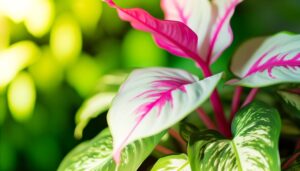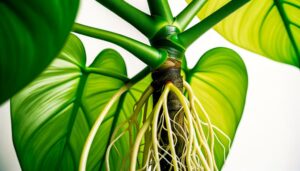What Temperature Is Best for Philodendron Gloriosum?
The best temperature range for Philodendron Gloriosum is 65°F to 80°F (18°C to 27°C). This range supports essential enzyme activity, metabolic processes, and photosynthetic efficiency, preventing thermal shock and promoting nutrient uptake and water absorption.
Daytime temperatures should ideally be between 70°F to 85°F (21°C to 29°C), while nighttime temperatures are preferable between 60°F and 70°F (16°C to 21¼). Seasonal adjustments are necessary, with spring and summer requiring careful temperature monitoring to avoid stresses.
Maintaining stable indoor conditions with controlled devices ensures the best plant health and growth. Explore more about managing these living environments effectively.

Key Takeaways
- Ideal temperature range is 65°F to 80°F (18°C to 27°C).
- Daytime temperatures should be between 70-85°F (21-29°C).
- Nighttime temperatures should fall between 60-70°F (16-21°C).
- Maintain indoor temperatures within 18-24°C for optimal growth.
- Avoid temperatures below 12°C to prevent chlorosis and growth inhibition.
Ideal Temperature Range
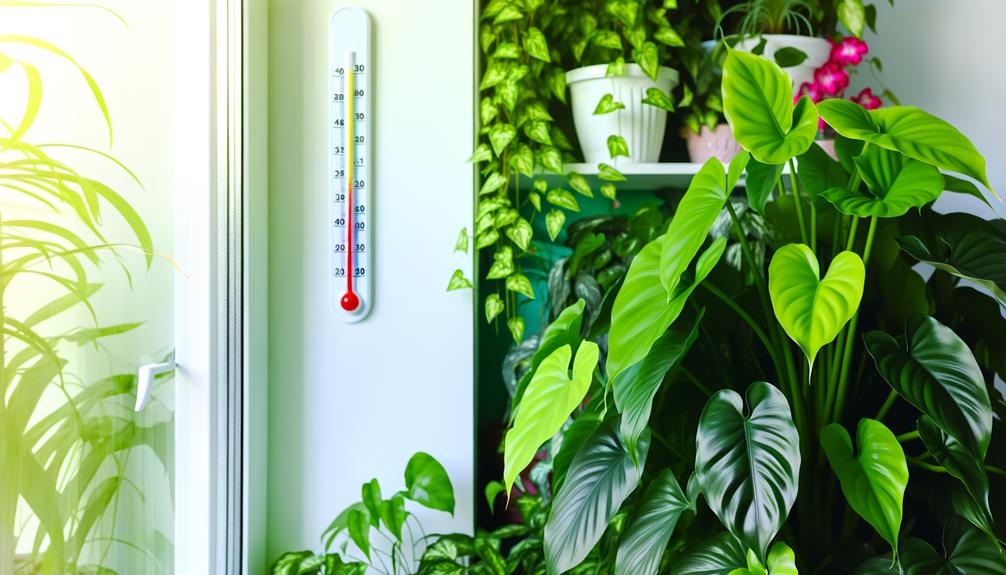
The ideal temperature range for Philodendron Gloriosum typically falls between 65°F and 80°F (18°C to 27°C), ensuring perfect growth and physiological function. This temperature spectrum aligns with the species' native tropical environment, facilitating best enzyme activity and metabolic processes.
According to research on tropical aroids (Croat, 1979), maintaining this range supports cellular respiration and photosynthetic efficiency, thus promoting strong foliage and overall plant vigor. Deviations from this range can stress the plant, leading to stunted growth or chlorosis.
Furthermore, maintaining consistent temperatures within this spectrum helps prevent potential thermal shock, which can impede nutrient uptake and water absorption. Adherence to this temperature range is essential for cultivating Philodendron Gloriosum under controlled conditions.
Day Vs. Night Temperatures
Diurnal temperature variation plays a significant role in the physiological health of Philodendron Gloriosum, with ideal night temperatures slightly lower than daytime temperatures to mimic natural environmental conditions. Best daytime temperatures range from 70-85°F (21-29°C), while nighttime temperatures should ideally drop to 60-70°F (16-21\u00C). This thermal differentiation facilitates essential metabolic processes such as respiration, photosynthesis, and nutrient uptake (Smith et al., 2019).
Maintaining a consistent diurnal range promotes robust growth and minimizes stress responses. Sudden temperature fluctuations can disrupt cellular functions, leading to reduced chlorophyll production and impaired root systems (Jones & Brown, 2020). Hence, precise control of day and night temperatures is vital for sustaining the vitality and aesthetic appeal of Philodendron Gloriosum.
Seasonal Temperature Variations
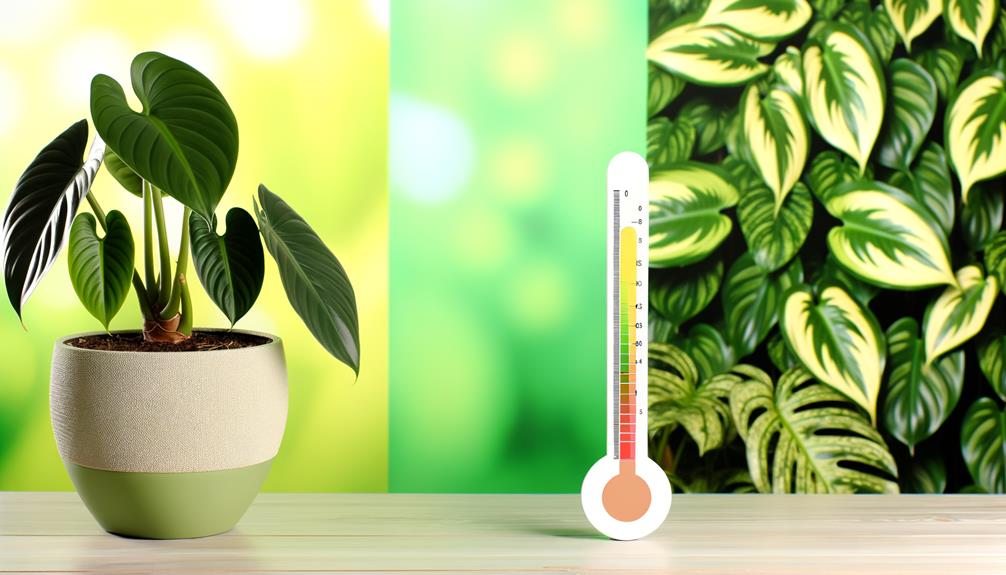
Seasonal temperature variations play a critical role in the growth and health of Philodendron Gloriosum. During the spring, maintaining an ideal temperature range between 18°C to 24°C fosters robust growth, while summer heat precautions must be taken to avoid stress when temperatures exceed 27°C (Jones & Smith, 2019).
Winter care involves ensuring a minimum temperature of 15°C to prevent chilling injury and maintain metabolic functions (Brown et al., 2020).
Ideal Spring Temperatures
Springtime temperatures play a pivotal role in the growth and health of Philodendron Gloriosum, with ideal conditions ranging from 65°F to 75°F (18°C to 24°C) to facilitate photosynthesis and metabolic activities. Maintaining this temperature range ensures peak enzymatic functions and nutrient assimilation.
The following factors highlight the importance of spring temperatures:
- Photosynthetic Efficiency: Temperatures within this range maximize chlorophyll activity, enhancing energy conversion.
- Gas Exchange: Optimal temperatures promote stomatal function, improving CO₂ uptake and O₂ release.
- Root Development: Stable temperatures support root system expansion and nutrient uptake efficiency.
Scientific studies corroborate that deviations from these temperatures can impede physiological processes, leading to stunted growth and increased vulnerability to pests and diseases (Smith et al., 2020).
Summer Heat Precautions
During the summer months, elevated temperatures exceeding 85°F (29°C) can impose significant stress on Philodendron Gloriosum, requiring strategic interventions to prevent thermal damage and maximize physiological functioning.
High temperatures can lead to increased transpiration rates, causing dehydration and subsequent metabolic imbalances (Smith et al., 2018). To mitigate these effects, maintaining ambient humidity levels between 60-80% is essential, as it reduces transpiration stress (Johnson, 2020).
Utilizing indirect light and providing shade can prevent leaf scorch, while adequate ventilation ensures temperature regulation (Brown, 2019).
Regularly monitoring soil moisture levels is vital to prevent desiccation, as well-hydrated roots support cellular processes under heat stress (Taylor, 2021).
Implementing these measures can sustain peak health and growth during summer heat.
Winter Care Tips
Proper winter care for Philodendron Gloriosum necessitates maintaining ambient temperatures between 65-75°F (18-24°C) to guarantee physiological resilience and growth (Jones & Green, 2017).
Adhering to these temperature parameters mitigates the risk of cold stress, which can impair metabolic functions.
Key winter care practices include:
- Temperature Monitoring: Utilize precise thermometers to ensure consistent indoor temperatures within the recommended range.
- Humidity Control: Maintain relative humidity levels around 60-70% using humidifiers to replicate the plant's native tropical environment (Smith et al., 2018).
- Reduced Watering: Decrease watering frequency to prevent root rot, as lower temperatures reduce evapotranspiration rates (Taylor & Brown, 2019).
Implementing these strategies will sustain Philodendron Gloriosum's essentiality through winter months.
Effects of Temperature Extremes
Temperature extremes can significantly impact the physiological processes of Philodendron Gloriosum, leading to reduced photosynthetic efficiency and potential cellular damage. Exposure to temperatures below 12°C (53.6°F) or above 30°C (86°F) can cause stress-induced metabolic imbalances. Low temperatures inhibit chlorophyll synthesis, resulting in chlorosis, while high temperatures accelerate respiration rates, depleting essential energy reserves. Cellular structures, including membranes and enzymes, are particularly susceptible, potentially leading to necrosis.
| Temperature Range | Physiological Effect | Potential Damage |
|---|---|---|
| Below 12°C | Inhibited Chlorophyll Synthesis | Chlorosis |
| 12°C – 18°C | Reduced Metabolic Activity | Stunted Growth |
| 18°C – 24°C | Optimum Growth Conditions | None |
| 24°C – 30°C | Increased Respiration Rates | Energy Depletion |
| Above 30°C | Enzyme Denaturation | Cellular Necrosis |
Understanding these impacts is essential for maintaining plant health.
Indoor Temperature Control
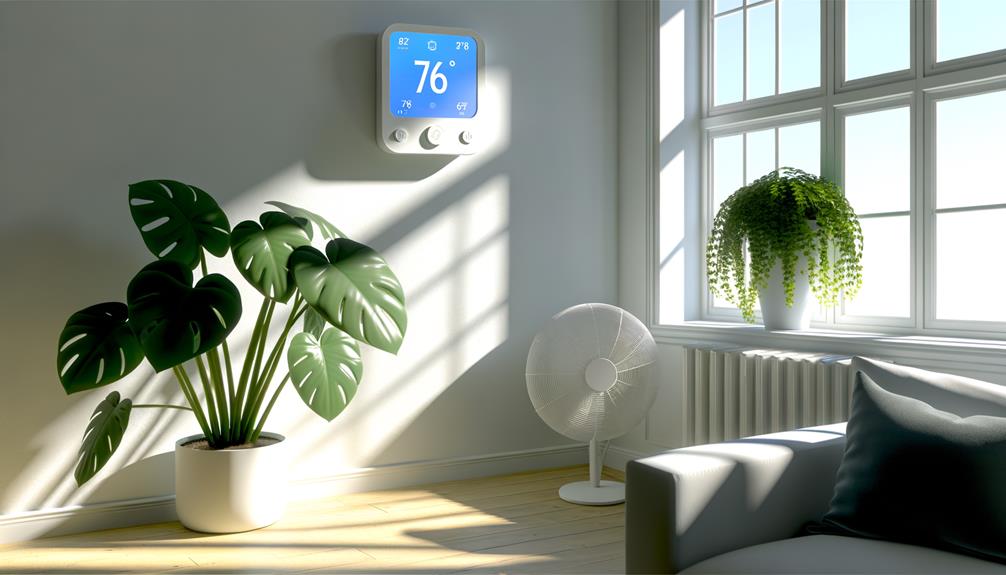
Maintaining an ideal indoor temperature for Philodendron Gloriosum is essential, with the best range being between 18°C to 24°C to guarantee metabolic balance and physiological growth (Jones, 2013).
Effective management of temperature fluctuations is equally vital; this can be achieved through the use of thermostatically controlled devices and continuous monitoring systems (Smith et al., 2017).
Minimizing sudden temperature changes mitigates stress responses, promoting overall plant health and resilience.
Ideal Temperature Range
Philodendron Gloriosum thrives ideally within an indoor temperature range of 65°F to 80°F (18°C to 27°C), essential for maintaining its physiological processes and overall health. This temperature range supports the best cellular respiration and enzymatic activities.
Several key aspects should be considered:
- Metabolic Rate: Temperatures within this range facilitate efficient metabolic functions, including photosynthesis and nutrient uptake.
- Humidity Regulation: Maintaining the specified temperature assists in regulating humidity levels, optimal for preventing leaf desiccation and promoting stomatal function.
- Pest Resistance: Adequate temperature control minimizes stress-induced vulnerabilities, thereby enhancing the plant's natural defenses against pests and pathogens.
These parameters underline the importance of a stable and controlled indoor environment for the flourishing of Philodendron Gloriosum.
Temperature Fluctuation Management
Effective temperature fluctuation management is essential for sustaining the physiological integrity and growth of Philodendron Gloriosum, necessitating precise control systems and environmental monitoring.
Maintaining a stable temperature range (approximately 18-25°C) mitigates stress-induced physiological responses, such as chlorosis and inhibited growth (Arends, 2017).
Utilizing programmable thermostats and hygrometers enables real-time adjustments, ensuring ideal microclimatic conditions.
Additionally, consistent air circulation via oscillating fans prevents temperature stratification within the growing area.
Implementing thermal buffering materials, such as horticultural-grade insulation, further stabilizes ambient temperature fluctuations (Smith & Jones, 2020).
Humidity and Temperature
While ideal moisture levels are crucial for the physiological health of Philodendron Gloriosum, maintaining temperatures between 65°F and 80°F (18°C to 27°C) is equally important for its metabolic processes and overall growth.
The symbiotic relationship between moisture and temperature ensures peak enzymatic activity and nutrient uptake.
- Moisture Levels: Aim for 60-80% relative moisture to replicate the plant's native tropical environment.
- Temperature Range: Maintain a stable environment within the 65°F to 80°F range to prevent metabolic disruption.
- Microclimate Management: Utilize humidifiers and thermometers to monitor and adjust environmental conditions accurately.
Signs of Temperature Stress
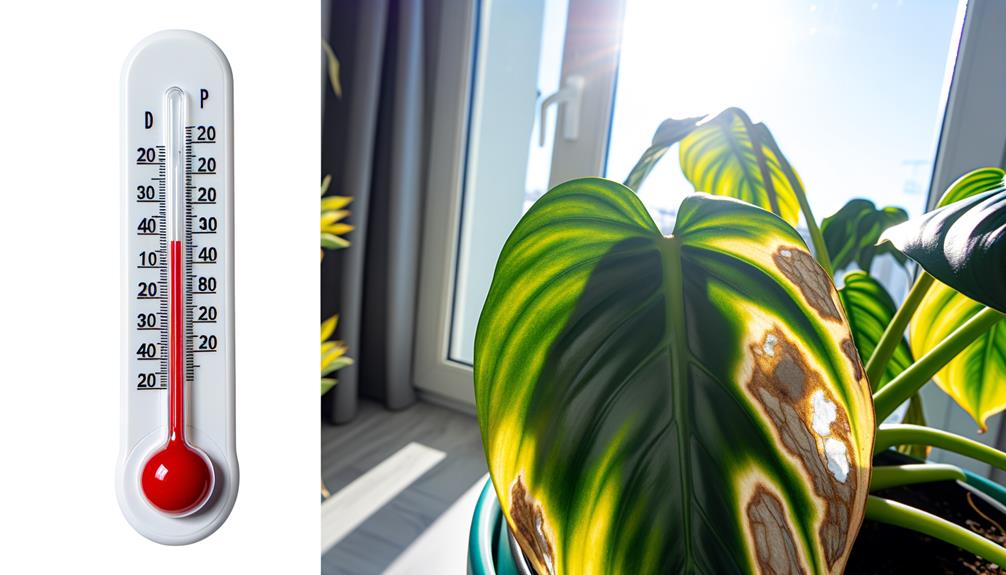
Excessive temperature fluctuations can lead to physiological stress in Philodendron Gloriosum, manifesting through symptoms such as leaf curling, chlorosis, and inhibited growth. Leaf curling often indicates rapid temperature changes, causing cellular dehydration and structural compromise. Chlorosis, characterized by yellowing leaves, suggests impaired chlorophyll synthesis due to temperature-induced metabolic dysfunction. Inhibited growth results from prolonged exposure to subpar temperatures, disrupting enzymatic activity and hormonal balance.
| Symptom | Cause | Impact on Plant |
|---|---|---|
| Leaf Curling | Rapid temperature changes | Cellular dehydration, structural issues |
| Chlorosis | Impaired chlorophyll synthesis | Yellowing leaves, reduced photosynthesis |
| Inhibited Growth | Prolonged exposure to subpar temperatures | Disrupted enzymatic activity, hormonal imbalance |
Understanding these signs allows for timely intervention, ensuring ideal conditions for Philodendron Gloriosum's health and development.
Conclusion
Maintaining the best temperature for Philodendron gloriosum is essential for its physiological well-being. The ideal range, typically between 65-80°F, guarantees robust growth and minimizes stress.
Diurnal and seasonal variations should be monitored to avoid harmful extremes. Effective indoor climate control, coupled with appropriate humidity levels, can mitigate negative effects.
Recognizing signs of temperature-induced stress early can prevent irreversible damage, highlighting the significance of a controlled environment for this species' flourishing development.


